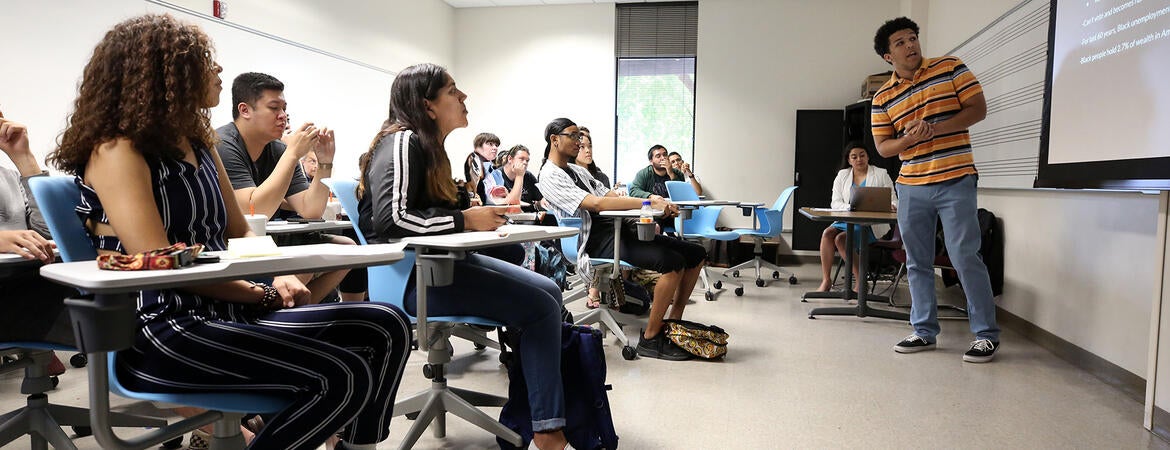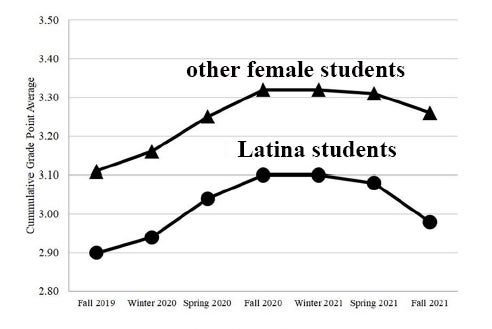
Latina college students often juggle responsibilities that extend beyond attending classes, studying for exams, and completing assignments.
While pursuing higher education, many must also fulfill family obligations, such as caring for younger siblings and aging parents, as well as contributing financially to their households.
These additional responsibilities contributed to a disproportionate impact of the COVID-19 pandemic on their academic performance, a study by UC Riverside scholars and administrators has found. While all college students lost ground on average, the study found Latina students at UC Riverside were particularly affected by the pandemic, as measured by online class enrollment, course completion rates, and grades earned.
These setbacks followed remarkable gains for Latino and Latina students, including a 50% increase in college enrollment nationwide between 2009 and 2019, said lead author Christine Victorino, an associate professor of practice at UCR’s School of Education.
"Latinas and Latinos had really gained a lot," Victorino said. "There was almost a doubling of enrollment. It was good news—and then, bam—the pandemic happened."
Latina and Latinos students both lost ground in terms of courses completed and grades but Latina setbacks were greater than female students from other demographic groups, the study found.
"We weren’t initially looking at Latina students specifically," Victorino said. "We were trying to understand why all students were taking fewer units after the pandemic. But when we drilled down into the data, it became clear that Latina students were uniquely affected."
For example, during the winter quarter of 2021, Latina students earned an average of 13.44 college credits—nearly one credit less than other female UCR students, the study found. Their grade point averages also dropped just below 3.0 in fall 2021, compared to about 3.1 before the pandemic.
During the pandemic, many students took fewer units. However, even after UCR resumed in-person classes in fall 2021, Latina students continued to enroll in fewer courses than their female peers. Latinas also more frequently opted for online classes over in-person instruction. However, Victorino said that online courses provide fewer opportunities for engagement than in-person classes.
"First-generation students, in particular, benefit from being in a physical classroom where they can interact with peers and faculty," she said. "We need to be careful about offering online classes as the default. They might be more convenient for faculty and administrators, but they don’t work for every student—especially those facing multiple pressures at home."
To better understand the data, the study authors conducted interviews with several Latina students at UCR. A common theme emerged.
"They just faced multiple pressures," Victorino said. "They experience the ‘perfect daughter’ expectation—that you are in school, helping take care of the family, and earning an income. As first-generation college students, they are often expected to do it all."
One student described to the researchers the weight of these expectations: "I feel like a lot of Latina daughters have this experience where they’re kind of like the glue that holds the family together."
Others described their roles as family mediators or translators, with their families relying on them as breadwinners. One student said she was her parents' "retirement plan."
The study’s authors provided recommendations to help address these challenges:
• Limit Online-Only Instruction: While online learning is useful for some students, institutions should be cautious about expanding online courses without considering their impact on student success.
• Expand Support Programs: Ethnic and gender-based student programs, such as Chicano student programs, create family-like environments where Latina students feel supported.
• Improve Classroom Engagement: Instructors should create interactive, inclusive environments that foster engagement, particularly in online settings. Strategies include hybrid learning models that incorporate live discussions and peer interactions.
• Address Financial and Family Pressures: Universities should recognize that many Latina students balance academic work with significant family obligations. Offering childcare services or financial-planning resources could help ease these pressures.
The study, “Latin* Student Success After the COVID-19 Pandemic,” was published in the Journal of Hispanic Higher Education. The co-authors are Marsha Ing, Elizabeth Claassen Thrush, Scott Heil, Hayden Harris, Arlene Cano Matute, and Nicole Colchete. All are affiliated with UCR.





